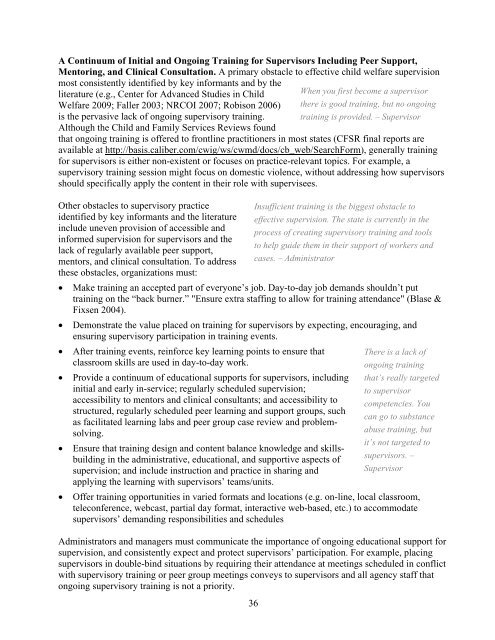Building a Model and Framework for Child Welfare Supervision
Building a Model and Framework for Child Welfare Supervision
Building a Model and Framework for Child Welfare Supervision
- No tags were found...
You also want an ePaper? Increase the reach of your titles
YUMPU automatically turns print PDFs into web optimized ePapers that Google loves.
A Continuum of Initial <strong>and</strong> Ongoing Training <strong>for</strong> Supervisors Including Peer Support,Mentoring, <strong>and</strong> Clinical Consultation. A primary obstacle to effective child welfare supervisionmost consistently identified by key in<strong>for</strong>mants <strong>and</strong> by theliterature (e.g., Center <strong>for</strong> Advanced Studies in <strong>Child</strong><strong>Welfare</strong> 2009; Faller 2003; NRCOI 2007; Robison 2006)is the pervasive lack of ongoing supervisory training.Although the <strong>Child</strong> <strong>and</strong> Family Services Reviews foundthat ongoing training is offered to frontline practitioners in most states (CFSR final reports areavailable at http://basis.caliber.com/cwig/ws/cwmd/docs/cb_web/SearchForm), generally training<strong>for</strong> supervisors is either non-existent or focuses on practice-relevant topics. For example, asupervisory training session might focus on domestic violence, without addressing how supervisorsshould specifically apply the content in their role with supervisees.Other obstacles to supervisory practiceInsufficient training is the biggest obstacle toidentified by key in<strong>for</strong>mants <strong>and</strong> the literature effective supervision. The state is currently in theinclude uneven provision of accessible <strong>and</strong>process of creating supervisory training <strong>and</strong> toolsin<strong>for</strong>med supervision <strong>for</strong> supervisors <strong>and</strong> theto help guide them in their support of workers <strong>and</strong>lack of regularly available peer support,mentors, <strong>and</strong> clinical consultation. To address cases. – Administratorthese obstacles, organizations must:• Make training an accepted part of everyone’s job. Day-to-day job dem<strong>and</strong>s shouldn’t puttraining on the “back burner.” "Ensure extra staffing to allow <strong>for</strong> training attendance" (Blase &Fixsen 2004).• Demonstrate the value placed on training <strong>for</strong> supervisors by expecting, encouraging, <strong>and</strong>ensuring supervisory participation in training events.• After training events, rein<strong>for</strong>ce key learning points to ensure thatclassroom skills are used in day-to-day work.There is a lack ofongoing training• Provide a continuum of educational supports <strong>for</strong> supervisors, including that’s really targetedinitial <strong>and</strong> early in-service; regularly scheduled supervision;to supervisoraccessibility to mentors <strong>and</strong> clinical consultants; <strong>and</strong> accessibility to competencies. Youstructured, regularly scheduled peer learning <strong>and</strong> support groups, suchcan go to substanceas facilitated learning labs <strong>and</strong> peer group case review <strong>and</strong> problemsolving.abuse training, butit’s not targeted to• Ensure that training design <strong>and</strong> content balance knowledge <strong>and</strong> skillsbuildingin the administrative, educational, <strong>and</strong> supportive aspects ofsupervisors. –supervision; <strong>and</strong> include instruction <strong>and</strong> practice in sharing <strong>and</strong>Supervisorapplying the learning with supervisors’ teams/units.• Offer training opportunities in varied <strong>for</strong>mats <strong>and</strong> locations (e.g. on-line, local classroom,teleconference, webcast, partial day <strong>for</strong>mat, interactive web-based, etc.) to accommodatesupervisors’ dem<strong>and</strong>ing responsibilities <strong>and</strong> schedulesAdministrators <strong>and</strong> managers must communicate the importance of ongoing educational support <strong>for</strong>supervision, <strong>and</strong> consistently expect <strong>and</strong> protect supervisors’ participation. For example, placingsupervisors in double-bind situations by requiring their attendance at meetings scheduled in conflictwith supervisory training or peer group meetings conveys to supervisors <strong>and</strong> all agency staff thatongoing supervisory training is not a priority.36When you first become a supervisorthere is good training, but no ongoingtraining is provided. – Supervisor
















